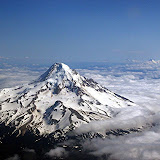
Birth of a Blog
Years of flight experience have not changed one simple fact. Flying is GREAT! It is fun, it keeps your mind disciplined and your senses sharp. It gives you a unique perspective on the world nearly incomprehensible to non pilots. Flying is one of the most profound experiences in my life and it is my hope that through these writings you may be inspired to deepen your own understanding of flight and perhaps, if you have not already done so, take on a new challenge and learn to fly
I've always loved flight. I have a memory, as a child of perhaps four, looking up at an aircraft passing overhead, silver fuselage and slanted wings, silvery grey in a white-blue sky with contrails streaming. The jet was passing left to right. We were in a playground, getting ready to leave. It was an early spring day as I remember the cold air on my face. My left hand in my Father's hand. "Airplane!" I shouted. I remember the transcendent feeling, and the joy at getting it all right, the use of the word, the knowledge of what the distant object was, the affirming nod and smile from my Dad.
That was decades ago, and I've not stopped enjoying flight. From kite building and plastic models in elementary school, flight lessons in high school, becoming a glider pilot, commercial pilot, flight instructor, chief flight instructor, aviation video and software developer, published aviation novelist, owner of an aerial photography business, owner of an antique aircraft, article writer for the Southern California Flight Standards District Office, charter pilot, glider pilot, tail-wheel pilot and antique aircraft owner and aficionado, my life has included aviation and flight since my earliest memories. My license and medical are current, though I am not flying as much as I'd like at the moment. I write about it, mentor a few pilots in the AOPA Mentor program, and watch for what opportunity may bring my way next.
The intent of this blog is four-fold; to share advice I give as a Mentor Pilot & Instructor, to chronologically share log entries from my logbook that may be of interest, to provide flying product and destination reviews based on my experiences and through 'flyosophy,' or flight philosophy, to examine ways in which aviation could be improved now or in the future for the betterment of individuals and the community at large. I be live aviation, if utilized to the fullest extent of our imagination, could make our world better in immeasurable ways.
My intent with this blog is to help pilots advance their skills, to provide knowledge about aircraft, products and destinations, to share lessons I've learned and documented in my logbook, and through 'flyosophy' to awaken the sense of curiosity and the drive towards excelling in and exploring our physical world that is uniquely understood only by those who actively fly.
The four approaches -
Mentor - proven techniques from years of CFI experience
Flyosophy - philosophy of flight in the present and for the future
LogBlog - lessons learned from flights in the log
Reviews - aircraft, flying products & destinations
It is my hope this blog will prove useful, enjoyable and thought provoking. I welcome comments and will respond as best I can.
Onward & Upward! - rfb
























